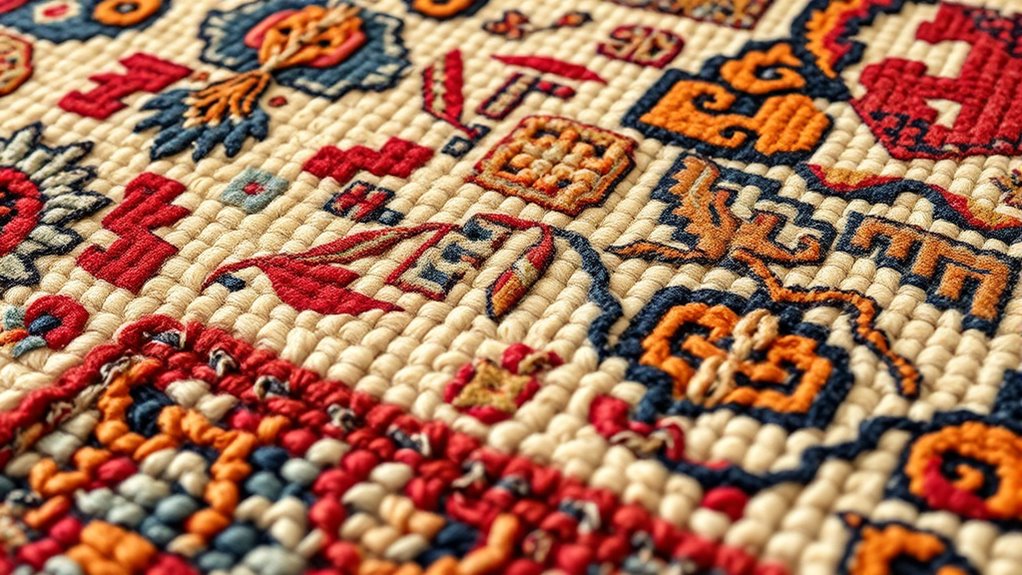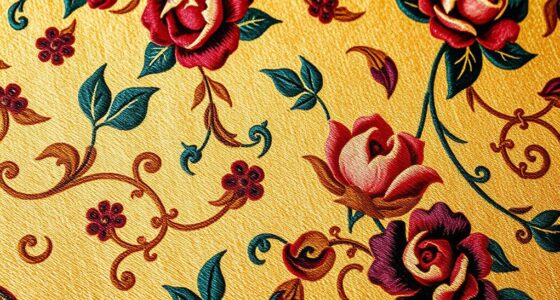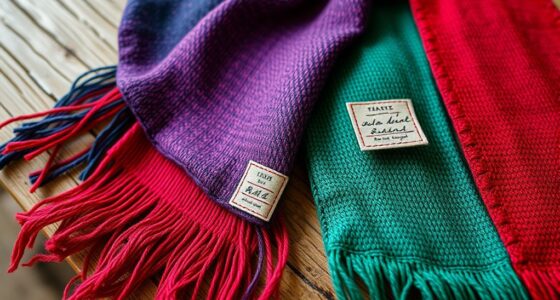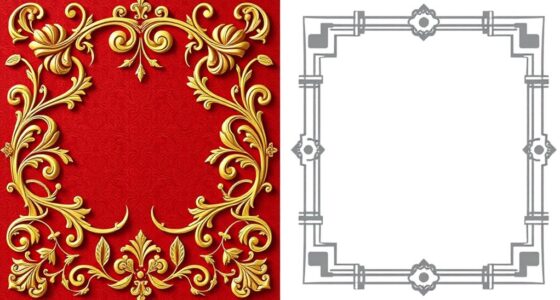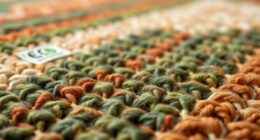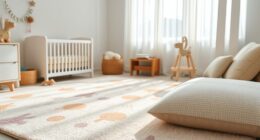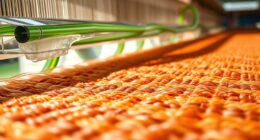To recognize a $10K rug’s true value, focus on seven key signals. Check the material and dye quality—natural fibers and authentic dyes guarantee longevity and vibrancy. Examine knot density and craftsmanship—tight, even knots and consistent patterning matter. Look for symmetry, color authenticity, and a solid finish with proper backing. Provenance and certification confirm authenticity, while overall feel reveals meticulous craftsmanship. Mastering these indicators will help you identify genuine high-end rugs—more tips await if you keep exploring.
Key Takeaways
- Assess material and dye quality, focusing on natural fibers and authentic dyes for lasting vibrancy and craftsmanship.
- Examine knot density and construction for durability, ensuring tight, consistent knots and superior craftsmanship.
- Check pattern symmetry and alignment to verify precise, high-quality weaving and authentic artistry.
- Verify provenance and certification to confirm authenticity and protect your investment.
- Evaluate visual and tactile cues like uniform knotting, vibrant colors, and balanced texture for overall craftsmanship.
Material Quality and Fiber Type

When evaluating a $10,000 rug, understanding the material quality and fiber type is essential. High-end rugs often feature natural fibers like wool, silk, or cotton, which provide durability and a luxurious feel. Be cautious of synthetic blends, which may lower the rug’s value despite mimicking natural textures. These blends are sometimes used for decorative accents, adding visual appeal but not necessarily enhancing longevity. The fiber type influences not only the look and feel but also how well the rug ages. Authentic materials generally indicate superior craftsmanship and quality. Recognizing these differences helps you determine if the rug’s material justifies its price. Always ask for detailed fiber information to ensure you’re investing in a genuine, high-quality piece rather than a synthetic substitute. Additionally, understanding self watering plant pots can help you appreciate how material choices affect overall durability and performance.
Knot Density and Construction
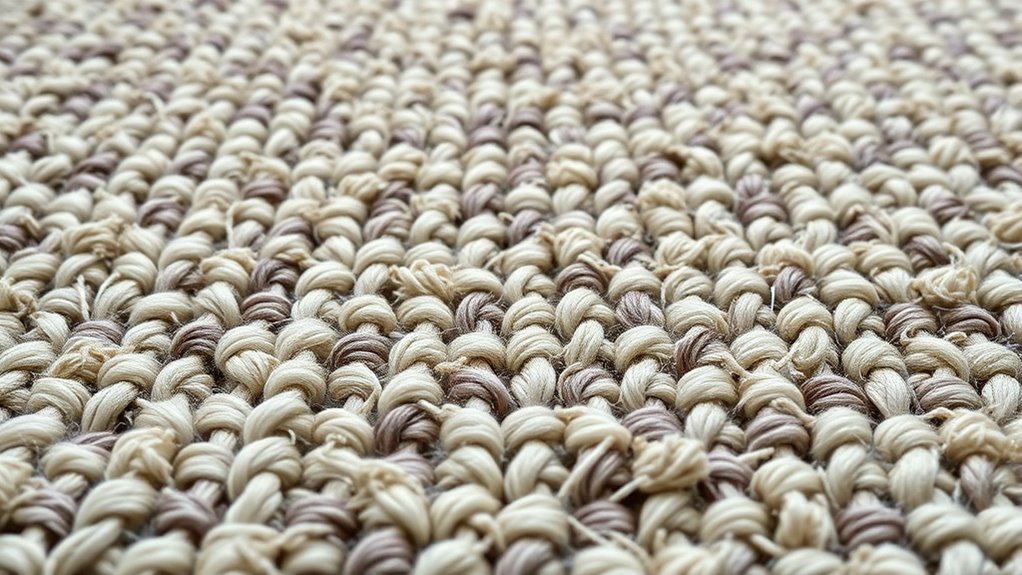
Knot density and construction are key indicators of a rug’s craftsmanship and durability. Higher knot density means more knots per square inch, which typically results in finer detail and a more resilient rug. Pay attention to construction techniques, as they reveal how carefully the rug was made. Hand-knotted rugs with tight, consistent knots tend to last longer and showcase superior artistry. Look closely at the back of the rug—if the knots are uniform and tightly packed, it’s a sign of quality craftsmanship. Conversely, loose or uneven knots can indicate inferior construction. A well-constructed rug not only looks better but also holds up over time, making it a worthwhile investment for a $10K purchase. Detecting passive voice in the description can help ensure your writing remains clear and engaging.
Symmetry and Pattern Precision
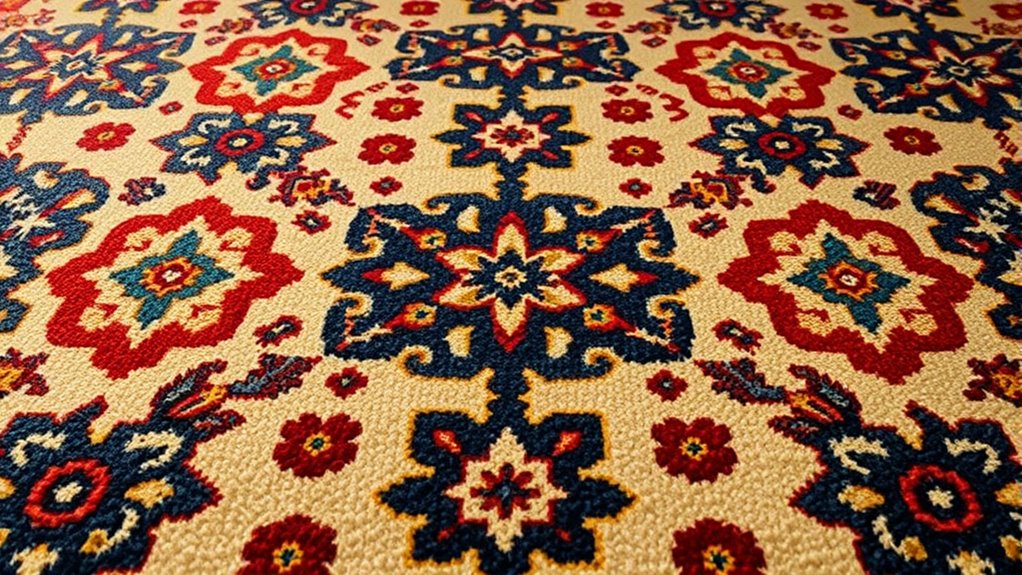
You’ll want to examine how well the rug’s symmetry is aligned, using specific techniques to verify any uneven areas. Check for pattern consistency across different sections to ensure the design flows seamlessly. Attention to these details can reveal the craftsmanship behind a high-quality $10K rug. Incorporating antique elements thoughtfully can also enhance the authenticity and character of the piece. Additionally, understanding the performance and reliability of materials used can help assess durability and overall quality. Being aware of user consent management practices can also be beneficial when evaluating online sources for such high-end purchases. Moreover, inspecting the quality signals like pattern precision and craftsmanship can provide further assurance of the rug’s value and authenticity. Recognizing the regional origin of the rug can also contribute to understanding its provenance and potential worth.
Symmetry Alignment Techniques
Achieving perfect symmetry and pattern precision is essential for high-quality $10K rugs, as even slight misalignments can markedly reduce their value. To guarantee this, expert weavers use precise symmetry alignment techniques, carefully matching patterns during weaving. Attention to detail in dyeing methods also helps maintain consistency across the rug’s entire design. Techniques like double-checking pattern alignment throughout the process prevent deviations. You should examine the rug’s design from multiple angles, looking for uniformity in pattern repetition. Pattern consistency plays a crucial role in maintaining the rug’s overall aesthetic appeal. Proper quality control measures during production further ensure that symmetry and pattern precision are upheld at every stage. These measures often include visual inspections to catch inconsistencies early, safeguarding the rug’s craftsmanship. Incorporating weaving guides can also assist artisans in maintaining alignment throughout the intricate process. Here’s a quick overview:
| Technique | Purpose |
|---|---|
| Thread matching | Ensures pattern continuity |
| Symmetry checkpoints | Detects misalignments early |
| Weaving pattern guides | Maintains pattern accuracy |
| Consistent dyeing methods | Preserves color and pattern integrity |
| Pattern edge alignment | Ensures seamless pattern flow |
A thorough inspection of the rug’s symmetry and pattern precision can reveal subtle imperfections that impact overall quality.
Pattern Consistency Checks
To guarantee your rug maintains its high value, conducting thorough pattern consistency checks is essential. Examine the design motifs carefully to ensure they are symmetrical and aligned correctly across the entire rug. Inconsistent motifs or irregularities can indicate shortcuts in the manufacturing processes, reducing the rug’s overall quality. Look for precise pattern repetition, especially in areas where symmetry should be perfect. Authentic high-end rugs typically feature meticulous craftsmanship, with pattern details matching seamlessly on both sides and throughout the piece. Variations or distortions may suggest machine-made origins or inferior production methods. Paying close attention to design symmetry helps verify your rug reflects the artistry and quality expected of a genuine, high-value piece. Additionally, inspecting the pattern precision can reveal the level of craftsmanship involved, ensuring the rug meets high standards of quality. Recognizing weaving techniques can also offer insights into the rug’s authenticity and durability, further supporting your evaluation process. Moreover, understanding the manufacturing methods can help distinguish between handcrafted and machine-made rugs, which is crucial for assessing value. Incorporating knowledge of tanning processes may also provide clues regarding the age and origin of the rug, adding another layer to your assessment.
Color Authenticity and Dye Quality

You should check for true color accuracy to verify the rug’s hues are genuine and consistent. Natural dye indicators reveal if the colors were created with authentic materials rather than synthetic ones. By focusing on these signs, you can better assess the rug’s quality and authenticity.
True Color Accuracy
Ever wondered how to tell if a rug’s colors are truly authentic? True color accuracy depends on dye stability and resistance to color fading. Authentic dyes maintain their vibrancy over time, ensuring your rug looks fresh for years. To spot genuine color, look for consistency across the entire piece. Here’s a quick comparison:
| Aspect | Synthetic Dyes | Natural Dyes | Authentic Dyes |
|---|---|---|---|
| Color Brightness | Usually overly vibrant or dull | Subtle, nuanced hues | Rich, balanced tones |
| Fading | Rapid, uneven color loss | Slow, even fading, if any | Maintains color integrity |
| Dye Stability | Less stable, prone to bleeding | Highly stable, resistant to fading | Long-lasting, true to original |
Authentic dyes promise enduring, true colors—an essential quality for a $10K rug.
Natural Dye Indicators
Natural dye indicators reveal genuine color authenticity and high dye quality by showing subtle variations and depth that synthetic dyes can’t replicate. When examining a rug, look for natural dye indicators such as slight color shifts or uneven saturation, which signal authentic craftsmanship. Organic dye markers often display nuanced shades, indicating the use of traditional, eco-friendly dyes rather than uniform, overly vibrant colors from synthetic sources. These indicators help you distinguish high-quality rugs because natural dyes age beautifully, developing a richer patina over time. By paying attention to natural dye indicators, you ensure the rug’s colors are genuine and the dyeing process was carefully executed. Recognizing these organic dye markers is essential for identifying a rug’s true quality, especially at premium price points like $10K.
Finish and Backing Consistency
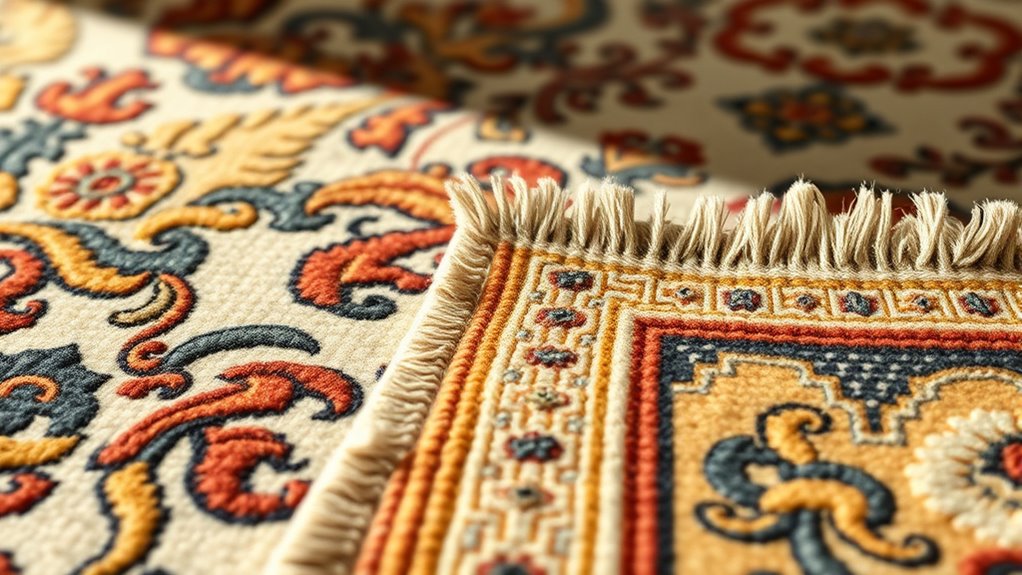
Consistent finish and backing are essential indicators of quality in high-end rugs, reflecting careful craftsmanship and durability. Look closely at the fringe finishing—well-sewn, even, and securely attached fringes indicate attention to detail. Uneven or loose fringes can suggest rushed or subpar work. Backing stability is equally important; a sturdy, tightly woven backing ensures the rug’s longevity and maintains its shape over time. Check for uniformity in the backing material, with no puckering or loose threads. These signs show that the rug was crafted with precision and care, not just for aesthetics but for lasting performance. When both the fringe finishing and backing stability are consistent, you know you’re investing in a rug that’s built to stand the test of time.
Provenance and Certification

The story behind a rug’s craftsmanship often adds significant value, and verifying its provenance and certification can help confirm authenticity and quality. Provenance reveals the rug’s history, including any antique restoration or previous ownership, and highlights its cultural significance. Certification from reputable organizations assures you of genuine origin, especially for high-value pieces. This documentation helps prevent forgery and guarantees your investment. When examining provenance, consider the following:
| Aspect | Significance |
|---|---|
| Antique Restoration | Indicates careful preservation, enhancing value |
| Cultural Significance | Connects the rug to its authentic regional heritage |
Understanding these signals ensures your $10K rug isn’t just beautiful but also authentic and meaningful.
Overall Craftsmanship and Feel
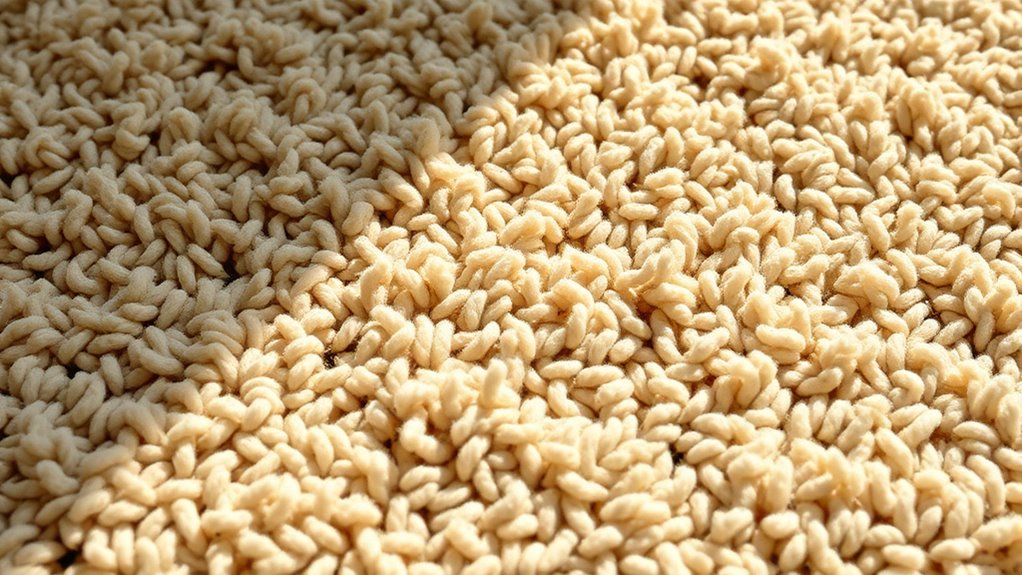
When evaluating a $10K rug, paying close attention to its overall craftsmanship and feel can reveal much about its quality. The hand feel offers insight into the rug’s construction—smooth, dense, and balanced textures indicate expert weaving. A well-crafted rug should feel substantial yet soft, with no loose threads or uneven areas. Visual appeal complements this by showcasing consistent knotting and vibrant, harmonious colors. The craftsmanship becomes evident in the rug’s symmetry and the precision of its patterns. A high-quality rug exudes a sense of durability and refinement through its tactile and visual qualities. Ultimately, the combined impact of exceptional hand feel and meticulous visual appeal confirms that you’re investing in a piece built to last and to impress.
Frequently Asked Questions
How Can I Identify a Genuine Antique Rug Versus a Reproduction?
To tell apart an antique vs reproduction rug, focus on details like craftsmanship and material. Authentic antiques often have signs of age, such as wear, fading, and hand-knotted fibers. Reproductions might look too perfect or uniform. For authenticity verification, carefully examine the rug’s backing, dye colors, and knot density. Consulting an expert or appraiser can also confirm if your rug is genuinely antique or a reproduction.
What Signs Indicate Poor Durability in High-Quality Rugs?
You’ll instantly notice poor durability if the fiber deterioration is rapid or the color fading is extreme—it’s like your rug’s losing its life fast! Crumbling fibers, frayed edges, and uneven wear show weak construction. If colors fade easily or patches look worn out, your rug isn’t built to last. These signs scream that your high-quality rug might not stand the test of time, despite its pricey appearance.
How Do Environmental Factors Affect Rug Longevity and Appearance?
Environmental factors like UV exposure and humidity control considerably impact your rug’s longevity and appearance. Excessive sunlight can fade colors, while high humidity promotes mold and mildew, weakening fibers. To protect your investment, keep your rug out of direct sunlight and maintain stable humidity levels. Use UV protectants and dehumidifiers if needed, ensuring your rug retains its beauty and durability for years to come.
Are There Specific Maintenance Tips to Preserve Color Vibrancy?
Think of your rug’s color vibrancy as a delicate flower that needs care. To preserve dye preservation, avoid harsh sunlight and use UV-protective window treatments. Regularly vacuum with gentle cleaning techniques to prevent dirt from dulling colors. Consider professional cleaning for deep maintenance. These simple steps act like a shield, keeping your rug’s hues lively and beautiful for years to come.
What Should I Look for in a Trustworthy Rug Dealer or Seller?
When choosing a trustworthy rug dealer, you should look for authentic sourcing and transparent pricing. A reliable seller openly shares the rug’s origin, ensuring it’s genuine, and provides clear, upfront prices without hidden fees. You’ll want to see positive reviews, ask for certification if available, and feel confident they prioritize quality and honest business practices. This way, you’re more likely to invest in a beautiful, authentic piece that meets your expectations.
Conclusion
Now that you’re armed with these 7 signals, you can spot a quality rug like a pro. Don’t just take the seller’s word for it—trust your eyes and instincts. Remember, a good rug is an investment, and knowing what to look for can save you from getting burned. Keep your wits about you, because when it comes to rugs, it’s better to be safe than sorry. Happy hunting!
